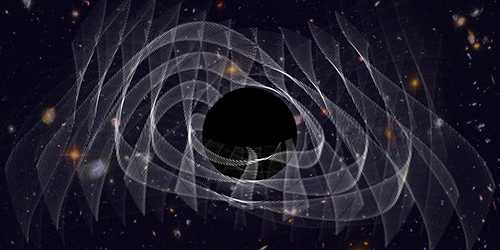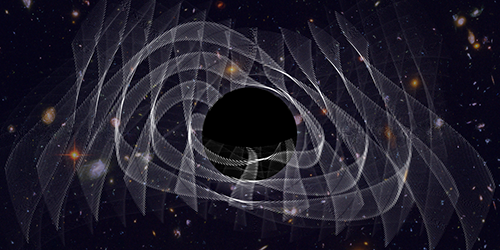Hunting for Hair on Coalescing Black Holes
A black hole resulting from the merger of two smaller black holes exists for the first few milliseconds in a distorted state. As its geometry stabilizes, it radiates a gravitational waveform whose shape carries information about its mass, spin, and in principle, electrical charge. General relativity predicts that these quantities alone are sufficient to describe any black hole—there are no other distinguishing features, or “hair.” Taking a new look at the first gravitational waves ever detected (known as GW150914), Maximiliano Isi, of the Massachusetts Institute of Technology, Cambridge, and colleagues from the California Institute of Technology, Pasadena, and the Flatiron Institute, New York, have now tested this no-hair theorem through an approach dubbed black-hole spectroscopy. The approach entails an in-depth analysis of the frequency spectrum of the gravitational-wave signal.
Previous studies had assumed that the signal dynamics immediately following a merger were too complex to be analyzed because of large nonlinear distortions in the spacetime dynamics. The researchers, however, found that this early “ringdown” period can be described by a simple linear combination of damped oscillating modes: the longest-lived fundamental mode and at least one more rapidly decaying overtone. If the no-hair theorem holds, it should constrain the frequencies and decay rates of these signals to certain values.
The team’s analysis supports the theorem, but the test’s precision will greatly improve by analyzing future mergers, the authors suggest. Black-hole spectroscopy could also one day rule out the possibility that what we think of as black holes are actually black hole “mimickers”—conjectured compact objects like boson stars or gravastars that lack an event horizon. Their properties would show up as deviations from the ringdown signatures predicted by general relativity.
This research is published in Physical Review Letters.
–Marric Stephens
Marric Stephens is a freelance science writer based in Bristol, UK.
Correction (12 September 2019): The article was revised to correctly list the affiliations of the authors.





